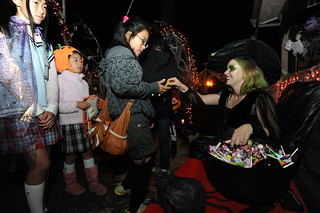https://www.flickr.com/photos/audiolucistore/7403731050/
Photo courtesy of www.audio-luci-store.it / Flickr CC
Written by Courtney Battle
Among all of the recent headlines in the news, one that may have caught your eye was a story reported by KMOX-TV, which explained that the Superintendent of Edwardsville, Illinois District Seven schools directed teachers to not to talk about, and to change the subject, if Michael Brown or the recent events in Ferguson, Missouri came up in classroom discussion. The story has undoubtedly sparked quite a bit of interest in the media. For example, Melissa Harris-Perry dedicated her ‘Open Letter’ segment of a recent show to Ed Hightower, the Superintendent, and Valerie Strauss covered the story in a post for the Washington Post’s Answer Sheet blog. Twitter has even gotten in on the action with the hashtag, #fergusonsyllabus, created by Marcia Chatelain, Assistant Professor in the History department at Georgetown University. There’s no doubt that the news of Michael Brown’s death and the subsequent events in Ferguson has sparked conversation in our country about race, community relationships with the police, and justice. However, it also begs the larger question of ‘Do we talk to students about difficult current events, and if so, how?’
Depends on who you ask, apparently. KMOX’s report reads “Hightower says normally there would be an open discussion of current events.” The Superintendent goes on to say, “However, this situation in Ferguson-Florissant has become a situation whereby there are so many facts that are unknown.” On the opposite side of the spectrum, teacher David B. Cohen writes in a post for the InterACT blog:
I think we have to be willing to toss out the lesson plan, or revise it. This must be done thoughtfully and advisedly, of course. A teacher needs to know the students, the community, and have the skills and sense to manage whatever is about to replace the regular lesson. But certainly, if we place the lesson plan ahead of significant moments in our communal life, we not only rob students of a chance to learn something more lasting and potentially important, but we also unwittingly reinforce the oft-heard but incorrect message that school is separate from “the real world.”
We definitely cannot ignore the events in Ferguson, or any other recent headlines for that matter, as they directly impact the “real world” that Cohen references. We live, work, and play in this world, and after students leave school for the day, they’re going out into the same world. That said, how can we address kids when things happen? Why is it important for them to engage on current events?
Education World tells us that there are several benefits to incorporating news into curriculums. Not only can students gain language, reading comprehension, and critical thinking skills, but they can also become informed citizens and open up a more adult-like dialogue with their parents.
Mock trials and mapping developing news stories, are a couple of the activities that Thomas N. Turner, Professor of Education at the University of Tennessee, suggests in his 1995 article for The Social Studies, “Riding the Rapids of Current Events.” For older students, having organized debates could also be an option. Maybe a good place to start, as Harris-Perry suggests, is reading a book as a class or exploring how music and other forms of art are often modes of expression on politics and news. Given, the approach has to be tailored to the specific students that you are teaching, but there are several ways to engage children on what’s happening in the world.
Whatever the approach may be, what’s important is not pretending that something didn’t happen. Kids know what’s going on, whether they hear a conversation their parents are having, flip past the news on tv, or if one of their classmates mention something he or she saw or heard. In addition, there’s the internet! Today’s children are all using Twitter, Facebook, Instagram, and countless other social media outlets that report and spark conversation on just about everything. Acknowledging a difficult current event, and from there using it as a ‘teachable moment,’ will help students process what has happened, but in the end they’ll also be better for it.






